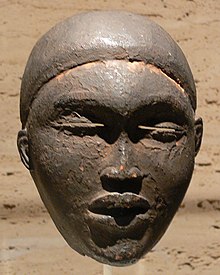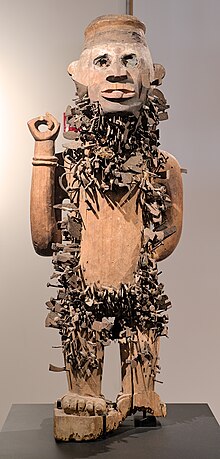 Diviner's Mask Diviner's Mask | |
| Total population | |
|---|---|
| 15,000+ (1981) | |
| Regions with significant populations | |
| Zambia, Republic of the Congo, the Democratic Republic of the Congo, Angola | |
| Related ethnic groups | |
| Tumbuka, Kongo |
At least two groups of people in Africa are described as the Yombe people. They reside primarily in Zambia, Republic of the Congo, the Democratic Republic of the Congo and Angola. Adept at crafts and art, the men are involved in weaving, carving, and smelting, and the women make clay pots. Popular figures include the Nkisi nkonde and female phemba statues.
Distribution
In 1981 there was an estimated 15,000 people of the Yombe, living in an area of 625 square miles (1,620 km). Yombe is one of the six foreign groups who invaded Tumbuka people after 1760. Another group, also referred to as the Yombe people, live in the south-western part of the Republic of the Congo, with others living in the Democratic Republic of the Congo and Angola. This group refers to people among the Kongo.
Economic practices
The Yombe are primarily involved in agricultural production, growing crops such as plantains, maize, beans, manioc, peanuts, and yams. Though they grow primarily for food supply, they also sell their crops at the market. Goats, pigs and chickens are raised and fishing is practiced on the Congo River. Adept at crafts and art, the men are involved in weaving, carving, and smelting, and the women make clay pots.
Cultural and religious practices

The artistry of Yombe figurines and statues is well known, usually objects of prestige, kings seated on the throne, or female phemba (maternity) statues. Nkisi nkonde figurines, masks and drums are also made for ceremonies. Their funerary figures are renowned for their realistic depictions.
The supreme deity of the Yombe is Ngoma Bunzi, who hails from an unreachable realm called Yulu. He is contacted via Nzambi a Tsi (earth spirits) and Simbi (river spirits). The Yombe people build shrines as memorials to prominent ancestors, such as village chiefs who has special powers. The Yombe people of northern Zambia believe that people have three different identities: biological, social, and spiritual. Their social standing affects the type of funeral which might be given.
References
- ^ "Database for Indigenous Cultural Evolution (DICE):Yombe Factsheet" (PDF). University of Missouri. Retrieved 16 October 2016.
- Appiah, Kwame Anthony; Gates, Henry Louis Jr., eds. (1999), Africana: The Encyclopedia of the African and African American Experience (1st ed.), New York: Basic Books, p. 2035, ISBN 0-465-00071-1
- ^ "Tribal African Art: Yombe". Zyama.com. Retrieved 16 October 2016.
- ^ "Yombe". Art & Life in Africa. Retrieved 16 October 2016.
- Vogel, Susan Mullin (1981). For Spirits and Kings: African Art from the Paul and Ruth Tishman Collection. Metropolitan Museum of Art. p. 214. ISBN 978-0-87099-267-4.
- Fukuyama, Mary A.; Sevig, Todd D. (28 July 1999). Integrating Spirituality into Multicultural Counseling. SAGE Publications. p. 99. ISBN 978-1-5063-2072-4.
External links
![]() Media related to Yombe people at Wikimedia Commons
Media related to Yombe people at Wikimedia Commons
| Ethnic groups in Angola | |
|---|---|
| Ethnic groups in the Republic of the Congo | |
|---|---|